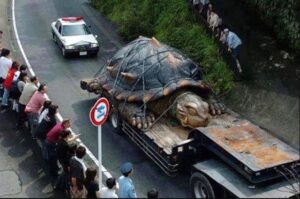
The city was alive with a palpable sense of wonder and excitement, as if the very air shimmered with anticipation. It wasn’t every day that the streets were graced with a spectacle so extraordinary, so gleaming with the sheen of history and natural marvel. The source of this buzz was none other than an enormous vehicle carefully transporting a colossal 350-year-old turtle, an ancient behemoth weighing an astonishing 650 pounds. This was not just any turtle; it was a living relic, a testament to centuries past, lumbering through time with the wisdom of ages etched into the grooves of its formidable shell.
As the vehicle made its way through the city, throngs of people gathered along the sidewalks, their eyes wide with curiosity and awe. They pointed and whispered, sharing stories and snippets of information that had spread like wildfire the moment news of the turtle’s arrival was announced. This giant turtle, affectionately nicknamed “Titan,” had become an instant celebrity, a symbol of endurance and resilience, quietly embodying the mysteries of the natural world that humans still strive to comprehend.
The logistics of transporting such a massive creature were as impressive as the turtle itself. An entire team of experts had been assembled, including wildlife biologists, veterinarians, and transportation specialists, all dedicated to ensuring Titan’s safe journey. The vehicle, a specially designed trailer equipped with temperature controls and cushioned supports, moved at a steady pace, mindful of its precious cargo. Inside, Titan appeared serene, its ancient eyes reflecting a calm wisdom, seemingly unfazed by the commotion surrounding it.
The turtle’s journey was not simply a spectacle but also an educational opportunity, a chance to raise awareness about conservation efforts and the role humans play in protecting such magnificent creatures. Local schools organized field trips, and educators seized the moment to teach students about marine biology, environmental stewardship, and the importance of preserving biodiversity. The city had transformed into an open-air classroom, where the turtle’s presence became a catalyst for learning and inspiration.
As Titan made its way through the city, it became a unifying force, drawing people from all walks of life together in shared admiration and respect. Families with young children, elderly couples, and solo adventurers all found common ground in their fascination with this living fossil. Conversations blossomed between strangers, and the city, often consumed by the fast pace of modern life, found a moment of pause, a collective breath taken in awe of nature’s grandeur.
The turtle’s journey culminated at a local marine sanctuary, where it would reside temporarily as part of a conservation program aiming to study and protect endangered species. There, researchers hoped to unlock the secrets of Titan’s longevity, to understand how it had managed to thrive for centuries against the odds. This knowledge, they believed, could offer vital insights into conservation strategies not just for turtles but for countless other endangered creatures.
As the city gradually returned to its usual rhythm, the memory of Titan’s passage lingered, leaving an indelible mark on the community. It was a reminder of the wonders that exist in our world, often hidden in the depths of the oceans or the shadows of forests, waiting to be discovered and cherished. In Titan, the city found not just a marvel to behold but a gentle reminder of the interconnectedness of all life and the responsibility humans hold in safeguarding the planet’s future.





